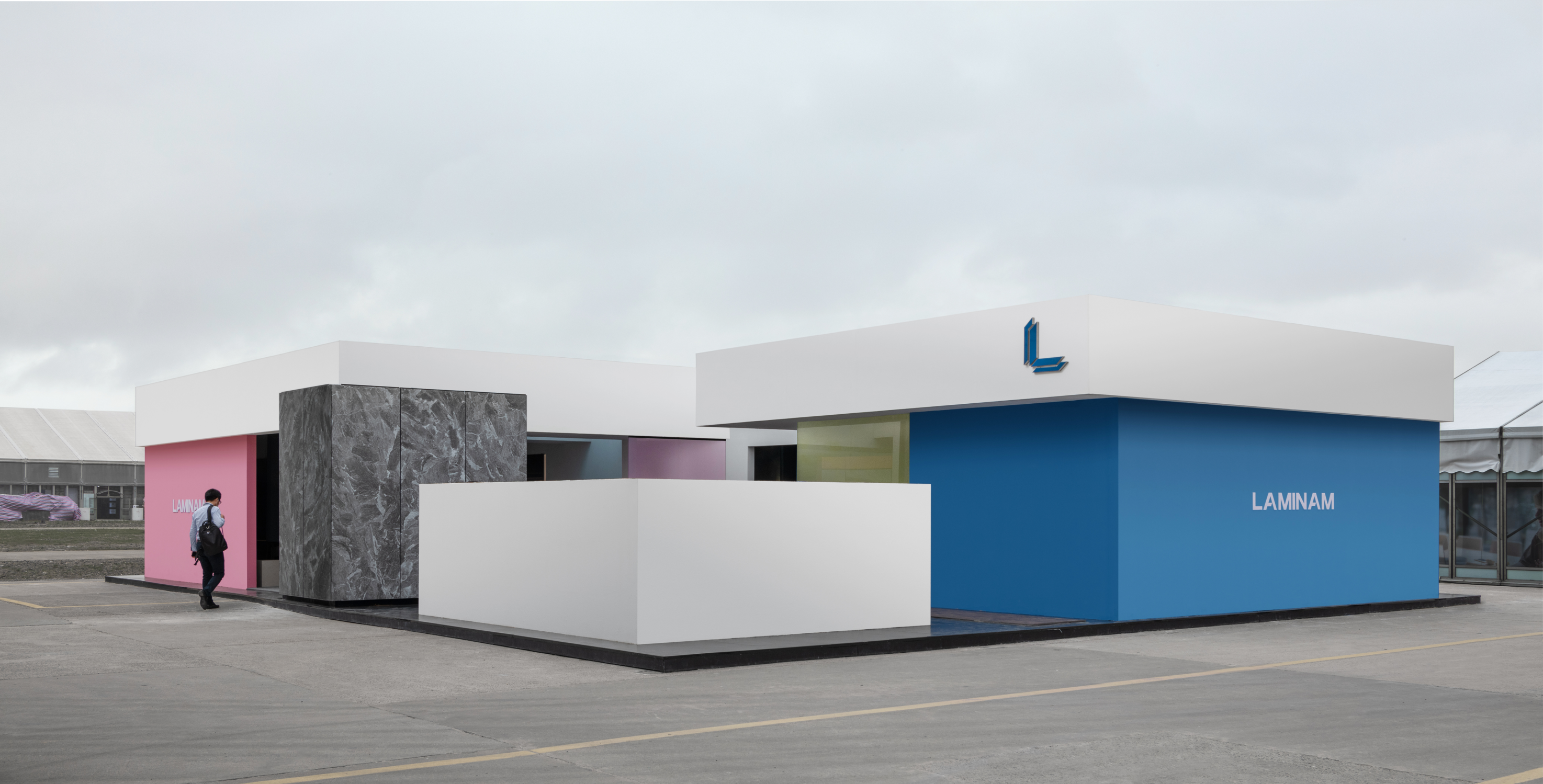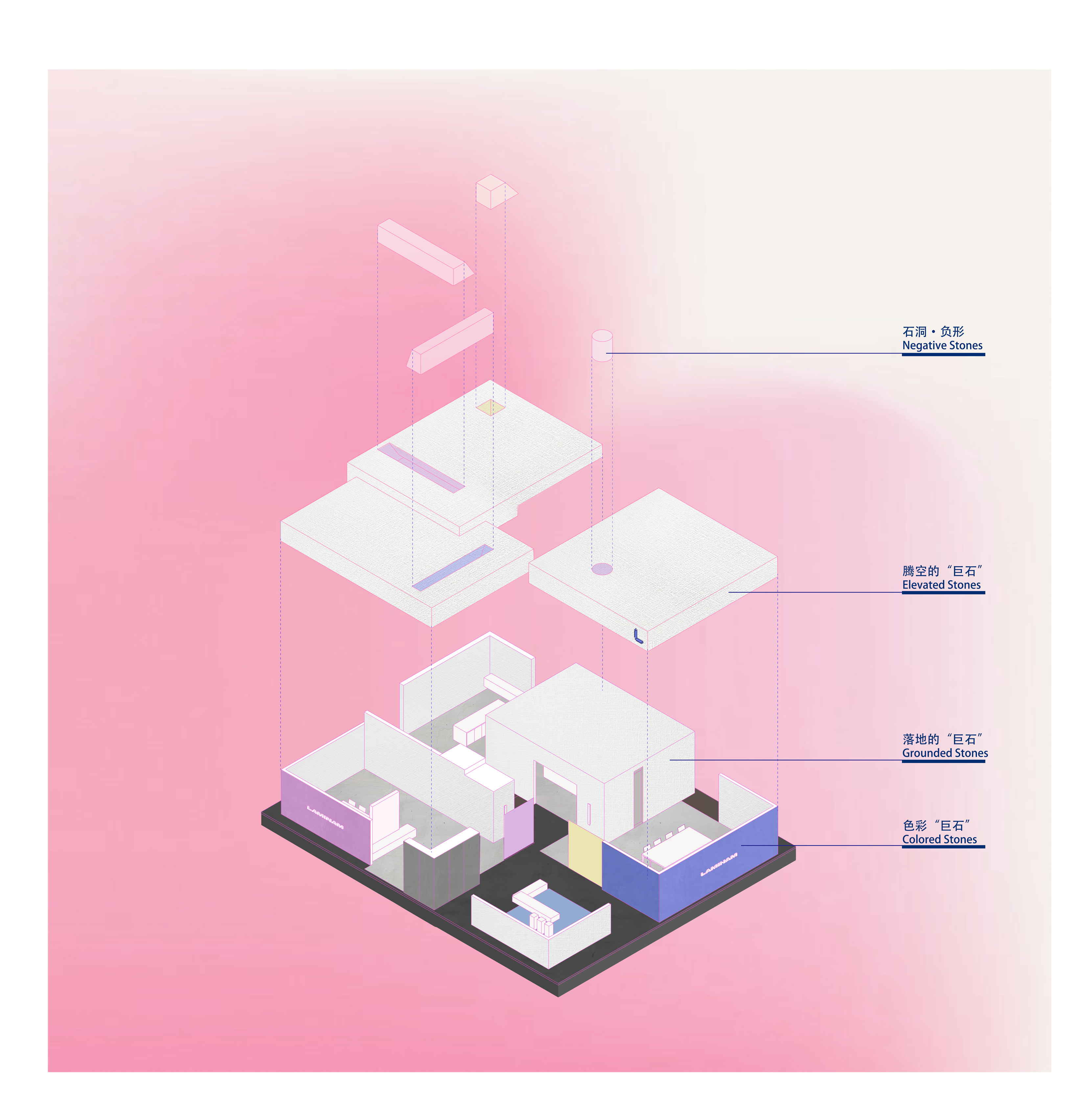
设计单位 朴居设计研究室(PUJU)
项目地点 中国上海
建成时间 2021年
建筑面积 320平方米
撰文 张润泽Renzo
…在这里,无数个节点同时隶属于两套系统
重叠、纠缠、相互交织在一起。
这必然导致透明性的空间组织,
标志着空间的转换...
——科林罗《透明性》
山 · 石 · 场
The Mountain. The Stone. The Field.
受业主委托,PUJU朴居設計研究室为其进口岩板品牌设计了一座300多平米的临时展厅建筑。
Commissioned by an Italian sintered stone brand, PUJU Design has designed a 320-square-metre temporary structure in Shanghai as its showroom.
岩板的原材料来自自然山石,展厅的设计则发想于石材的诞生地——采石场。在纪录片“II Capo”中,世界闻名的鱼肚白大理石的产地——意大利卡拉拉采石场——壮美如画,巨大的山体被纵横切割,石材的粉末漫天弥漫,整个场地洁白如玉,好像山地里一个巨大的舞台。另外一边,位于普罗旺斯的莱姆石采石场被Chanel选为去年新品发布的秀场。当身着艳丽服装的模特行走在采石场之中,被切割的山石成为了极具美感的抽象背景,时尚、自然、人工在这里交汇。
Sintered stone is manufactured using natural ingredient and with the technology which mimic the processes that form natural stones, which inspired us from the beginning of design. We started to look at the birth place of natural stones – the quarry. In the documentary “II Capo”, we were shocked by the beauty of the Carrara marble quarry in central Italy – the huge mountains cut with geometric shapes, the white powders of stones dancing in the air. It almost looks like a stage set. Meanwhile, the former limestone quarry in Province were used by Chanel as the runway to showcase their new collection. As the models sashayed in graphical dresses against the picturesque stony background, the idea of fashion is sparkling with the marriage between nature and man-made realities.


采石场拥有一种独特的美学气质。山体切割的几何性让我联想到马列维奇的至上主义绘画。若把他画作中的彩色方块想象成被切割的石块,这些石块或漂浮、或重叠、或散落,平面的画布似乎一下子拥有了三维的指向。他富有感染力的情绪,便有了化为三维空间的可能。
The quarry certainly enquires a unique aesthetics. The geometrical shapes on the mountains remind me of the suprematism works by Kazimir Malevich. If the colourful patches in his paintings were those stones in the quarry, floating, scattering, and intersecting with each other, the 2-dimensional painting seems to embody 3-dimensional possibilities. The passions and emotions are able to motivate a 3-dimensional creation.

在我们的设想中,“山·石·场”,借由一种至上主义的抽象和激情,成为形式构建的最初动机。将功能需求化作一系列抽象的巨石,在场地之中建立一个临时的“山·石·场”,既回应了展陈产品的基因,也融入了我们一贯探索坚持的极简抽象美学。
The mountain, the stone and the quarry field, with the shaping power of suprematic aesthetic, provided the initial motives for the design of the showroom. We intended to create a series of abstract stones, which is almost like a temporary corner of the stone quarry. It responds to the DNA of the sintered stone, as well as the minimal and abstract aesthetics that we have been exploring.
居 于 山 石
Living in the Stones
美学之外看山石,在其中居住也是一种横跨不同文化的人类居住的原始模型。Ensemble Studio借由被废弃的采石场,以床垫,窗帘,桌子等最小的介质介入,改造成了一处实验性的居所。人们从现代都市的玻璃盒子里出来,重新回到山石之中,文明的历史在这里反转,建筑也回到了原点。
Beyond the aesthetics, living-in-the-stones is a human living model which has existed since thousands of years ago and across different cultures. Ensemble Studio has renovated a former quarry to be an experimental living place, with a minimal intervention of furniture like curtains, mattress, etc. Human being are getting out of the glass and concrete boxes in the cities and getting back to the mountains and stones. The civilization process is reverted in the project and the architecture goes back to its purest form.

在金秋野的阅读中,阿道夫·路斯的Raumplan设计手法和中国园林隔空呼应,成为一种“室内造山”的方式。Ensemble Studio的项目虽然位于西班牙Menorca岛,在我看来却与传统园林中构建石头和人的关系有异曲同工之妙。这些石头来自自然,却服从于人的身体尺度,可漫游,可对望,可卧可倚,咫尺山林,寄托着人对于更大的天地自然的想象。我们将这种解读带入展厅的设计之中,意在创造一个可居可游的石群。
In the essay by Jing Qiuye, Raumplan, as coined by Aldof Loos, echoed with the method of Chinese Garden, becoming a way to create “mountains in the house”. In my reading of the project by Ensemble Studio, which locates in Menorca Island, shares the similar approaches with Chinese Gardens in deliberately creating rich possibilities of human being interacting with stones. These stones, cut to the scale of human body, become places to wander within, looking through, lying on and leaning upon. It embodies the imagination of a bigger world epitomized within a small house. We brought these reading to the design of the showroom and try to create stones that could be lived and wandered within.



层 岩 叠 影
Layered. Shadowed
寄托着抽象山石的美学和“居于山石”的人文想象, 设计的完成仍需要严谨的结构和合理的功能布局。场地被划分为4个展厅和一个前院四个展厅对应四组展示内容,以四块白色巨石定义。
With the idea of abstract stones and living-in-stones, the proposal develops with functional layout and structural precision. The site was divided as four showrooms and one front yard. The four rooms were defined with four huge white “stones”, which respectively exhibits four collections of products.


白色巨石有的落地,有的被带有色彩的巨石支撑,并且相互重叠,形成构成感强烈的立面和空间关系。
One of the white stones were grounded, white the others elevated by colorful stones. They intersecting with each other, creating a picturesque elevational composition.


入口以水池和小尺度的石头形成景观,呼应整体的空间概念并形成空间的序幕。
The entrance welcomed visitors with a square water pond and stones, which echoes with the overall concept in smaller scale.



进入内部后,空间流动而连续。不同的房间,结合屋顶和墙面的孔洞,形成彼此的对景,从不同角度形成穿透和对望关系。
The internal spaces are free and interconnected. Different showrooms were visually linked through cracks and holes.




由于形体交叠和穿透产生丰富的内部空间,而彩色玻璃和墙面则充当着空间的标识物并丰富空间的体验。
The internal space, because of the intersection and overlaying of white massing forms, reached a quality of “phenomenal transparency” as coined by Colin Rowe, whereas the colorful wall and glasses served as the marks for different spaces.



定制岩板灯具在墙面氤氲着微光,夹在超白玻璃、岩板、白色肌理漆墙面之间,在微观尺度上创造出“层岩叠影”的美学。
Customized sintered stone lights shed light upon the wall. The light were emitted through the gaps between glasses, sinter stone slabs and the white wall, creating the layered and shadowed imagery in micro scale.


“层岩叠影”的设计缘起于自然山石和抽象主义的美学嫁接,寄托着居于山石的诗意想象。由于实际条件的限制,这次展厅只能在一层平面上实现,在垂直空间层面的穿插留下更多未来探索的可能。
“Layered World” started with the marriage between natural stones and abstract expressionism, developed through the poetic visions of living-in-stone. Because of the practical reasons, the showrooms could only realize the concept in a single floor, leaving the vertical applications of the concept for future explorations.


完整项目信息
项目名称:层岩叠影
设计事务所:朴居设计研究室(PUJU)
项目地址:上海新国际博览中心
建筑面积:320平方米
主创设计:遥千、张润泽Renzo
设计团队:李诗楠Lexi、Ruby、王佶、夏清雅
设计时间:2021年2月—2021年6月
摄影:Guo Jing
文字/翻译:Renzo
版权声明:本文由朴居设计研究室授权发布。欢迎转发,禁止以有方编辑版本转载。
投稿邮箱:media@archiposition.com
上一篇:Dogma:不造房子的建筑师
下一篇:乌镇谭家湾步行桥:稻田水网上的交织和缠绕 / 东维建筑、浙江农林大学园林设计院